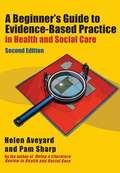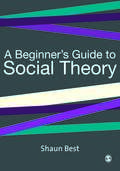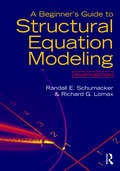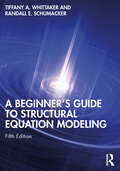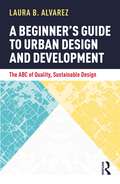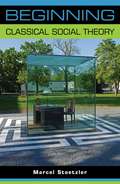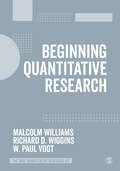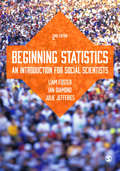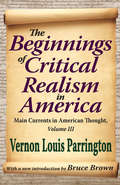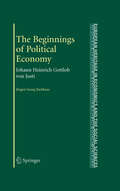- Table View
- List View
A Beginner’s Guide to Building Better Worlds: Ideas and Inspiration from the Zapatistas
by Levi Gahman Nasha MohamedThis ambitious book offers radical alternatives to conventional ways of thinking about the planet’s most pressing challenges, ranging from alienation and exploitation to state violence and environmental injustice. Bridging real-world examples of resistance and mutual aid in Zapatista territory with big-picture concepts like critical consciousness, social reproduction and decolonisation, the authors encourage readers to view themselves as co-creators of the societies they are a part of – and ‘be Zapatistas wherever they are'. Written by a diverse team of first-generation authors, this book offers an emancipatory set of anti-colonial ideas related to both refusing liberal bystanding and collectively constructing better worlds and realities.
A Beginner’s Guide to Building Better Worlds: Ideas and Inspiration from the Zapatistas
by Levi Gahman Nasha MohamedThis ambitious book offers radical alternatives to conventional ways of thinking about the planet’s most pressing challenges, ranging from alienation and exploitation to state violence and environmental injustice. Bridging real-world examples of resistance and mutual aid in Zapatista territory with big-picture concepts like critical consciousness, social reproduction and decolonisation, the authors encourage readers to view themselves as co-creators of the societies they are a part of – and ‘be Zapatistas wherever they are'. Written by a diverse team of first-generation authors, this book offers an emancipatory set of anti-colonial ideas related to both refusing liberal bystanding and collectively constructing better worlds and realities.
A Beginner's Guide To Evidence-based Practice In Health And Social Care
by Helen Aveyard Pam SharpHave you heard of 'evidence based practice' but don't know what it means? Are you having trouble relating evidence to your practice? This is the book for anyone who has ever wondered what evidence based practice is or how to relate it to practice. Fully updated in this brand new edition, this book is simple and easy to understand - and designed to help those new to the topic to apply the concept to their practice and learning with ease. The book provides a step by step guide to what we mean by evidence based practice and how to apply it. This new edition features: Additional material on literature reviews and searching for literature Even more examples for health and social care practice Extra material on qualitative research and evidence based practice Expanded section on hierarchies of evidence and how to use them A Beginner's Guide to Evidence Based Practice in Health and Social Care is key reading for everyone involved in looking at and applying evidence in healthcare.
A Beginner's Guide to Evidence-based Practice in Health and Social Care (Third Edition) (PDF)
by Helen Aveyard Pam SharpHave you heard of 'evidence-based practice' but don't know what it means? Are you struggling with relating evidence to your practice? Do you want a straight forward, clearly written and practical guide to evidence-based practice? This is the book for anyone who has ever wondered what evidence-based practice is, how to relate it to practice or use it in academic work. Fully updated in this brand new edition, this book uses simple and easy to understand language to help those new to the topic. It provides a step by step guide to what we mean by evidence-based practice and how to apply this concept to your practice and learning. This new edition features: • Additional explanations with examples from health and social care practice, using a wider range of reviews and research • Inclusion of contemporary issues such as predatory journals, use of social media and rapid reviews • Practical solutions to the challenges of using more and better evidence in busy practice settings and in academic work • Revised and expanded useful web links highlighted throughout the book • Clearer explanations of difficult research terms and an updated glossary • New end-of-chapter quizzes to help assess how much you have learned. A Beginner's Guide to Evidence-Based Practice in Health and Social Care, 3rd Edition is key reading for both students and professionals who need to search for, appraise and apply evidence in nursing, allied health care or social care.
A Beginner′s Guide to Social Theory
by Shaun Best`This book is accessible, as a beginner′s guide should be, but without an over-simplification of the arguments. It should prove an immensely durable text for generations of students to come′ - John Hughes, Lancaster University At last, a book that makes social theory for undergraduates a pleasure to teach and study. The book offers a comprehensive overview of social theory from classical sociology to the present day. Students are guided through the work of Durkheim, Marx and Weber, functionalism, action perspectives, feminism, postmodernism and contemporary thinkers like Anthony Giddens, Michel Foucault, J[um]urgen Habermas, Frederic Jameson, Judith Butler, Gilles Deluze, Manuel Castells, Luce Irigary, Naomi Woolf and Camille Paglia. The book presents clear accounts of these contributions and employs an extensive range of activities that encourage the reader to evaluate the work of given theorists and approaches. The book is: - Comprehensive - Student-friendly - Accurate - Unpatronising It offers lecturers and students an ideal study resource for undergraduate modules in social theory.
A Beginner′s Guide to Social Theory
by Shaun Best`This book is accessible, as a beginner′s guide should be, but without an over-simplification of the arguments. It should prove an immensely durable text for generations of students to come′ - John Hughes, Lancaster University At last, a book that makes social theory for undergraduates a pleasure to teach and study. The book offers a comprehensive overview of social theory from classical sociology to the present day. Students are guided through the work of Durkheim, Marx and Weber, functionalism, action perspectives, feminism, postmodernism and contemporary thinkers like Anthony Giddens, Michel Foucault, J[um]urgen Habermas, Frederic Jameson, Judith Butler, Gilles Deluze, Manuel Castells, Luce Irigary, Naomi Woolf and Camille Paglia. The book presents clear accounts of these contributions and employs an extensive range of activities that encourage the reader to evaluate the work of given theorists and approaches. The book is: - Comprehensive - Student-friendly - Accurate - Unpatronising It offers lecturers and students an ideal study resource for undergraduate modules in social theory.
A Beginner's Guide to Structural Equation Modeling: Fourth Edition
by Richard G. Lomax Randall E. SchumackerNoted for its crystal clear explanations, this book is considered the most comprehensive introductory text to structural equation modeling (SEM). Noted for its thorough review of basic concepts and a wide variety of models, this book better prepares readers to apply SEM to a variety of research questions. Programming details and the use of algebra are kept to a minimum to help readers easily grasp the concepts so they can conduct their own analysis and critique related research. Featuring a greater emphasis on statistical power and model validation than other texts, each chapter features key concepts, examples from various disciplines, tables and figures, a summary, and exercises. Highlights of the extensively revised 4th edition include: -Uses different SEM software (not just Lisrel) including Amos, EQS, LISREL, Mplus, and R to demonstrate applications. -Detailed introduction to the statistical methods related to SEM including correlation, regression, and factor analysis to maximize understanding (Chs. 1 – 6). -The 5 step approach to modeling data (specification, identification, estimation, testing, and modification) is now covered in more detail and prior to the modeling chapters to provide a more coherent view of how to create models and interpret results (ch. 7). -More discussion of hypothesis testing, power, sampling, effect sizes, and model fit, critical topics for beginning modelers (ch. 7). - Each model chapter now focuses on one technique to enhance understanding by providing more description, assumptions, and interpretation of results, and an exercise related to analysis and output (Chs. 8 -15). -The use of SPSS AMOS diagrams to describe the theoretical models. -The key features of each of the software packages (Ch. 1). -Guidelines for reporting SEM research (Ch. 16). -www.routledge.com/9781138811935 which provides access to data sets that can be used with any program, links to other SEM examples, related readings, and journal articles, and more. Reorganized, the new edition begins with a more detailed introduction to SEM including the various software packages available, followed by chapters on data entry and editing, and correlation which is critical to understanding how missing data, non-normality, measurement, and restriction of range in scores affects SEM analysis. Multiple regression, path, and factor models are then reviewed and exploratory and confirmatory factor analysis is introduced. These chapters demonstrate how observed variables share variance in defining a latent variables and introduce how measurement error can be removed from observed variables. Chapter 7 details the 5 SEM modeling steps including model specification, identification, estimation, testing, and modification along with a discussion of hypothesis testing and the related issues of power, and sample and effect sizes.Chapters 8 to 15 provide comprehensive introductions to different SEM models including Multiple Group, Second-Order CFA, Dynamic Factor, Multiple-Indicator Multiple-Cause, Mixed Variable and Mixture, Multi-Level, Latent Growth, and SEM Interaction Models. Each of the 5 SEM modeling steps is explained for each model along with an application. Chapter exercises provide practice with and enhance understanding of the analysis of each model. The book concludes with a review of SEM guidelines for reporting research. Designed for introductory graduate courses in structural equation modeling, factor analysis, advanced, multivariate, or applied statistics, quantitative techniques, or statistics II taught in psychology, education, business, and the social and healthcare sciences, this practical book also appeals to researchers in these disciplines. Prerequisites include an introduction to intermediate statistics that covers correlation and regression principles.
A Beginner's Guide to Structural Equation Modeling: Fourth Edition
by Richard G. Lomax Randall E. SchumackerNoted for its crystal clear explanations, this book is considered the most comprehensive introductory text to structural equation modeling (SEM). Noted for its thorough review of basic concepts and a wide variety of models, this book better prepares readers to apply SEM to a variety of research questions. Programming details and the use of algebra are kept to a minimum to help readers easily grasp the concepts so they can conduct their own analysis and critique related research. Featuring a greater emphasis on statistical power and model validation than other texts, each chapter features key concepts, examples from various disciplines, tables and figures, a summary, and exercises. Highlights of the extensively revised 4th edition include: -Uses different SEM software (not just Lisrel) including Amos, EQS, LISREL, Mplus, and R to demonstrate applications. -Detailed introduction to the statistical methods related to SEM including correlation, regression, and factor analysis to maximize understanding (Chs. 1 – 6). -The 5 step approach to modeling data (specification, identification, estimation, testing, and modification) is now covered in more detail and prior to the modeling chapters to provide a more coherent view of how to create models and interpret results (ch. 7). -More discussion of hypothesis testing, power, sampling, effect sizes, and model fit, critical topics for beginning modelers (ch. 7). - Each model chapter now focuses on one technique to enhance understanding by providing more description, assumptions, and interpretation of results, and an exercise related to analysis and output (Chs. 8 -15). -The use of SPSS AMOS diagrams to describe the theoretical models. -The key features of each of the software packages (Ch. 1). -Guidelines for reporting SEM research (Ch. 16). -www.routledge.com/9781138811935 which provides access to data sets that can be used with any program, links to other SEM examples, related readings, and journal articles, and more. Reorganized, the new edition begins with a more detailed introduction to SEM including the various software packages available, followed by chapters on data entry and editing, and correlation which is critical to understanding how missing data, non-normality, measurement, and restriction of range in scores affects SEM analysis. Multiple regression, path, and factor models are then reviewed and exploratory and confirmatory factor analysis is introduced. These chapters demonstrate how observed variables share variance in defining a latent variables and introduce how measurement error can be removed from observed variables. Chapter 7 details the 5 SEM modeling steps including model specification, identification, estimation, testing, and modification along with a discussion of hypothesis testing and the related issues of power, and sample and effect sizes.Chapters 8 to 15 provide comprehensive introductions to different SEM models including Multiple Group, Second-Order CFA, Dynamic Factor, Multiple-Indicator Multiple-Cause, Mixed Variable and Mixture, Multi-Level, Latent Growth, and SEM Interaction Models. Each of the 5 SEM modeling steps is explained for each model along with an application. Chapter exercises provide practice with and enhance understanding of the analysis of each model. The book concludes with a review of SEM guidelines for reporting research. Designed for introductory graduate courses in structural equation modeling, factor analysis, advanced, multivariate, or applied statistics, quantitative techniques, or statistics II taught in psychology, education, business, and the social and healthcare sciences, this practical book also appeals to researchers in these disciplines. Prerequisites include an introduction to intermediate statistics that covers correlation and regression principles.
A Beginner's Guide to Structural Equation Modeling
by Tiffany A. Whittaker Randall E. SchumackerA Beginner’s Guide to Structural Equation Modeling, fifth edition, has been redesigned with consideration of a true beginner in structural equation modeling (SEM) in mind. The book covers introductory through intermediate topics in SEM in more detail than in any previous edition. All of the chapters that introduce models in SEM have been expanded to include easy-to-follow, step-by-step guidelines that readers can use when conducting their own SEM analyses. These chapters also include examples of tables to include in results sections that readers may use as templates when writing up the findings from their SEM analyses. The models that are illustrated in the text will allow SEM beginners to conduct, interpret, and write up analyses for observed variable path models to full structural models, up to testing higher order models as well as multiple group modeling techniques. Updated information about methodological research in relevant areas will help students and researchers be more informed readers of SEM research. The checklist of SEM considerations when conducting and reporting SEM analyses is a collective set of requirements that will help improve the rigor of SEM analyses. This book is intended for true beginners in SEM and is designed for introductory graduate courses in SEM taught in psychology, education, business, and the social and healthcare sciences. This book also appeals to researchers and faculty in various disciplines. Prerequisites include correlation and regression methods.
A Beginner's Guide to Structural Equation Modeling
by Tiffany A. Whittaker Randall E. SchumackerA Beginner’s Guide to Structural Equation Modeling, fifth edition, has been redesigned with consideration of a true beginner in structural equation modeling (SEM) in mind. The book covers introductory through intermediate topics in SEM in more detail than in any previous edition. All of the chapters that introduce models in SEM have been expanded to include easy-to-follow, step-by-step guidelines that readers can use when conducting their own SEM analyses. These chapters also include examples of tables to include in results sections that readers may use as templates when writing up the findings from their SEM analyses. The models that are illustrated in the text will allow SEM beginners to conduct, interpret, and write up analyses for observed variable path models to full structural models, up to testing higher order models as well as multiple group modeling techniques. Updated information about methodological research in relevant areas will help students and researchers be more informed readers of SEM research. The checklist of SEM considerations when conducting and reporting SEM analyses is a collective set of requirements that will help improve the rigor of SEM analyses. This book is intended for true beginners in SEM and is designed for introductory graduate courses in SEM taught in psychology, education, business, and the social and healthcare sciences. This book also appeals to researchers and faculty in various disciplines. Prerequisites include correlation and regression methods.
A Beginner's Guide to Urban Design and Development: The ABC of Quality, Sustainable Design
by Laura B. AlvarezThis book provides invaluable guidance to all those with an interest in placemaking and the built environment, from those with no experience to those who have worked for many years in industry, illustrating key principles that will secure higher quality, more sustainable design in accessible, jargon-free language. The author explains the design process in a straightforward way, exploring the different roles and highlighting the opportunities and limitations different agencies have to influence design over the various stages of the process. Examples from the UK and worldwide look at how the system operates and how best practice can make a real difference on the ground. Case studies examine situations where quality or sustainability fell short – and how this could have been avoided. This book also showcases a variety of evaluation tools, explaining how they operate, and giving guidance on how to create project-specific tools to drive schemes forward. With community empowerment at its core, the book explains technical language and shares bountiful knowledge to broaden place democracy and make influencing design accessible to many, not just a few. This is a book that brings together all the various parties involved in shaping the built environment, demonstrating that collaboration and mutual understanding are key to achieving better quality, more sustainable design.
A Beginner's Guide to Urban Design and Development: The ABC of Quality, Sustainable Design
by Laura B. AlvarezThis book provides invaluable guidance to all those with an interest in placemaking and the built environment, from those with no experience to those who have worked for many years in industry, illustrating key principles that will secure higher quality, more sustainable design in accessible, jargon-free language. The author explains the design process in a straightforward way, exploring the different roles and highlighting the opportunities and limitations different agencies have to influence design over the various stages of the process. Examples from the UK and worldwide look at how the system operates and how best practice can make a real difference on the ground. Case studies examine situations where quality or sustainability fell short – and how this could have been avoided. This book also showcases a variety of evaluation tools, explaining how they operate, and giving guidance on how to create project-specific tools to drive schemes forward. With community empowerment at its core, the book explains technical language and shares bountiful knowledge to broaden place democracy and make influencing design accessible to many, not just a few. This is a book that brings together all the various parties involved in shaping the built environment, demonstrating that collaboration and mutual understanding are key to achieving better quality, more sustainable design.
Beginning classical social theory (Beginnings)
by Marcel StoetzlerThis book introduces students and educated general readers to thirteen key social theorists by way of examining a single, exemplary text by each author, ranging from Comte to Adorno. It answers the need for a book that helps students develop the skill to critically read theory.
Beginning classical social theory (Beginnings)
by Marcel StoetzlerBeginning classical social theory introduces students and educated general readers to thirteen key social theorists by way of examining a single, exemplary text by each author, ranging from Comte to Adorno. It answers the need for a book that helps students develop the skill to critically read theory. Rather than learning how to admire the canonical theorists, readers are alerted to the flow of their arguments and the texts’ contradictions and limitations. Having gotten ‘under the skin’ of one key text by each author will provide readers with a solid starting point for further study. The book will be suitable as the principal textbook in social theory modules as much as alongside a more conventional textbook as a recommended additional tool for self-study. It will appeal to undergraduate and postgraduate students as well as educated lay readers.
Beginning Quantitative Research (The SAGE Quantitative Research Kit)
by Malcolm Williams Richard D. Wiggins W.P. VogtThis concise text provides a clear and digestible introduction to completing quantitative research. Taking you step-by-step through the process of completing your quantitative research project, it offers guidance on: · Formulating your research question · Completing literature reviews and meta-analysis · Formulating a research design and specifying your target population and data source · Choosing an appropriate method and analysing your findings Part of The SAGE Quantitative Research Kit, this book will give you the know-how and confidence needed to succeed on your quantitative research journey.
Beginning Quantitative Research (The SAGE Quantitative Research Kit)
by Malcolm Williams Richard D. Wiggins W.P. VogtThis concise text provides a clear and digestible introduction to completing quantitative research. Taking you step-by-step through the process of completing your quantitative research project, it offers guidance on: · Formulating your research question · Completing literature reviews and meta-analysis · Formulating a research design and specifying your target population and data source · Choosing an appropriate method and analysing your findings Part of The SAGE Quantitative Research Kit, this book will give you the know-how and confidence needed to succeed on your quantitative research journey.
Beginning Quantitative Research (The SAGE Quantitative Research Kit)
by Malcolm Williams Richard D. Wiggins W.P. VogtThis concise text provides a clear and digestible introduction to completing quantitative research. Taking you step-by-step through the process of completing your quantitative research project, it offers guidance on: · Formulating your research question · Completing literature reviews and meta-analysis · Formulating a research design and specifying your target population and data source · Choosing an appropriate method and analysing your findings Part of The SAGE Quantitative Research Kit, this book will give you the know-how and confidence needed to succeed on your quantitative research journey.
Beginning Statistics: An Introduction for Social Scientists
by Liam Foster Ian Diamond Julie BantonIn the Second Edition of this bestselling textbook, the authors use real-world examples to introduce basic principles in statistics with no prior knowledge or experience assumed. With an emphasis on describing concepts, showing through example and illustrating points with graphs and displays, this book will provide readers with a step-by-step introduction to using statistics. Chapters address the following questions: Why bother learning statistics in the first place and are they relevant to real life? How do I make sensible tables and informative graphs? What are descriptive and inferential statistics and how are they used? What are regression and correlation anyway?
Beginning Statistics: An Introduction for Social Scientists
by Liam Foster Ian Diamond Julie BantonIn the Second Edition of this bestselling textbook, the authors use real-world examples to introduce basic principles in statistics with no prior knowledge or experience assumed. With an emphasis on describing concepts, showing through example and illustrating points with graphs and displays, this book will provide readers with a step-by-step introduction to using statistics. Chapters address the following questions: Why bother learning statistics in the first place and are they relevant to real life? How do I make sensible tables and informative graphs? What are descriptive and inferential statistics and how are they used? What are regression and correlation anyway?
Beginning with Disability: A Primer
by Lennard J. DavisWhile there are many introductions to disability and disability studies, most presume an advanced academic knowledge of a range of subjects. Beginning with Disability is the first introductory primer for disaibility studies aimed at first year students in two- and four-year colleges. This volume of essays across disciplines—including education, sociology, communications, psychology, social sciences, and humanities—features accessible, readable, and relatively short chapters that do not require specialized knowledge. Lennard Davis, along with a team of consulting editors, has compiled a number of blogs, vlogs, and other videos to make the materials more relatable and vivid to students. "Subject to Debate" boxes spotlight short pro and con pieces on controversial subjects that can be debated in class or act as prompts for assignments.
Beginning with Disability: A Primer
by Lennard J. Davis Jay Dolmage Nirmala Erevelles Sarah Parker Harris Alexander Luft Susan Schweik Linda WareWhile there are many introductions to disability and disability studies, most presume an advanced academic knowledge of a range of subjects. Beginning with Disability is the first introductory primer for disaibility studies aimed at first year students in two- and four-year colleges. This volume of essays across disciplines—including education, sociology, communications, psychology, social sciences, and humanities—features accessible, readable, and relatively short chapters that do not require specialized knowledge. Lennard Davis, along with a team of consulting editors, has compiled a number of blogs, vlogs, and other videos to make the materials more relatable and vivid to students. "Subject to Debate" boxes spotlight short pro and con pieces on controversial subjects that can be debated in class or act as prompts for assignments.
The Beginnings of Critical Realism in America: Main Currents in American Thought
by Vernon ParringtonThis final volume of Vernon Louis Parrington's Pultzer Prize-winning study deals with the decay of romantic optimism. It shows that the cause of decay is attributed to three sources: stratifying of economics under the pressure of centralization; the rise of mechanistic science; and the emergence of a spirit of skepticism which, with teachings of the sciences and lessons of intellectuals, has resulted in the questioning of democratic ideals.Parrington presents the movement of liberalism from 1913 to 1917, and the reaction to it following World War I. He notes that liberals announced that democratic hopes had not been fulfilled; the Constitution was not a democratic instrument nor was it intended to be; and while Americans had professed to create a democracy, they had in fact created a plutocracy.Industrialization of America under the leadership of the middle class and the rise of critical attitudes towards the ideals and handiwork of that class are examined in great detail. Parrington's interpretation of the literature during this time focuses on four divisions of development: the conquest of America by the middle class; the challenge of that overlordship by democratic agrarianism; the intellectual revolution brought about by science and the appropriation of science by the middle class; and the rise of detached criticism by younger intellectuals. A new introduction by Bruce Brown highlights Parrington's life and explains the importance of this volume.
The Beginnings of Critical Realism in America: Main Currents in American Thought (Main Currents In American Thought Ser.)
by Vernon ParringtonThis final volume of Vernon Louis Parrington's Pultzer Prize-winning study deals with the decay of romantic optimism. It shows that the cause of decay is attributed to three sources: stratifying of economics under the pressure of centralization; the rise of mechanistic science; and the emergence of a spirit of skepticism which, with teachings of the sciences and lessons of intellectuals, has resulted in the questioning of democratic ideals.Parrington presents the movement of liberalism from 1913 to 1917, and the reaction to it following World War I. He notes that liberals announced that democratic hopes had not been fulfilled; the Constitution was not a democratic instrument nor was it intended to be; and while Americans had professed to create a democracy, they had in fact created a plutocracy.Industrialization of America under the leadership of the middle class and the rise of critical attitudes towards the ideals and handiwork of that class are examined in great detail. Parrington's interpretation of the literature during this time focuses on four divisions of development: the conquest of America by the middle class; the challenge of that overlordship by democratic agrarianism; the intellectual revolution brought about by science and the appropriation of science by the middle class; and the rise of detached criticism by younger intellectuals. A new introduction by Bruce Brown highlights Parrington's life and explains the importance of this volume.
The Beginnings of Political Economy: Johann Heinrich Gottlob von Justi (The European Heritage in Economics and the Social Sciences #7)
by Jügen Georg BackhausJu¨ rgen G. Backhaus 1 Johann Heinrich Gottlob (von) Justi was born in 1702 in Bru¨ cken in Prussia (county of Sangerhausen), studied law and cameral sciences in Wittenberg and Jena, yet had to leave the university, entered the Prussian military service, was captured during the Austrian war of succession by the Austrians but escaped to Leipzig (Saxony) where he studied mineral sciences. In 1750 he was called to a chair ‘‘Cameral Sciences and Rhetorics’’ at the new Theresian Academy of Knights in Vienna. There, he gave two important inaugural lectures which are the focal point of this book. In 1754, Justi was appointed a mineral counsellor in Gottingen ¨ (Hanover), and lectured at the Saxonian University on both state sciences and natural sciences. In 1762, Frederic II (the Great) of Prussia appointed him Prussian captain (highest supervisory position) of mines and general supervisor of fiscal-mineral activities. In 1768 he was accused of embezzlement, and before he could prove his innocence, he died in 1771 as a prisoner in the (decaying) fortress of Ku¨ strin. Due to his death, the case was never decided. But Frederic had obviously made his own decision. When he appointed Justi, the appointee pointed out that he was suffering from weak eye sight and could not readily check the bookkeeping. Frederic replied: You may have weak eyes but you have a bright mind. I shall put two eyes by your side.
Behandlungsabbruch am Lebensende: Die Beziehung zwischen kurativer und palliativer Behandlung – Eine Grounded Theory (Palliative Care und Forschung)
Ärzte haben die Pflicht, menschliches Leben zu retten und zu erhalten, aber nicht unter allen Umständen. Sofern es indiziert ist, müssen sie von kurativer Behandlung zu palliativmedizinischer Versorgung übergehen und damit einen Behandlungsabbruch durchführen. Die Autoren zeigen am Beispiel von Intensivmedizinern, dass die Erkenntnis, dass ein Patient stirbt, nicht nach naturwissenschaftlichen Parametern vorgenommen wird, dass ein Behandlungsabbruch ethisch schwer zu verantworten ist und gesetzliche Vorgaben und Richtlinien der Bundesärztekammer für Ärzte keine sicheren Entscheidungshilfen bieten.


